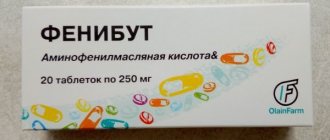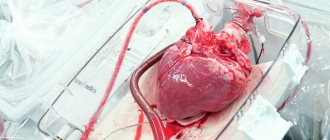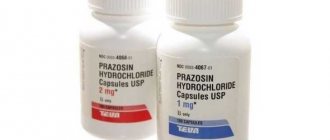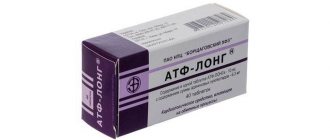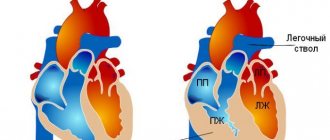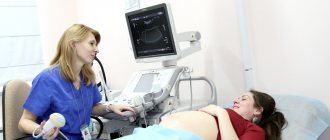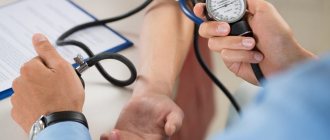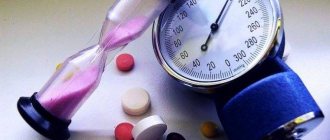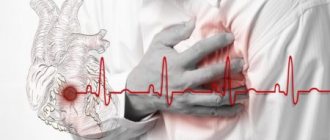Cardioprotectors are drugs that protect heart cells and improve metabolic processes in the myocardium. This class of drugs is relatively young, since it appeared on the pharmacological market in the mid-90s of the last century.
The heart muscle regularly requires a constant flow of oxygen from the blood, with the help of which phosphorylation processes occur in the myocardial tissues necessary to maintain the proper functioning of the heart. A low level of oxygen saturation of cardiac tissue (during ischemia) can be interpreted as an imbalance between the rate of transport of blood, which contains oxygen, and the need for it. If heart cells do not receive the required amount of oxygen, coronary heart disease (CHD) develops. In healthy people, tissue hypoxia also occurs against the background of high-intensity physical activity and psychological stress. As a result, the functionality of the heart muscle decreases, and as a result, symptoms of angina pectoris develop.
An excellent adaptation mechanism for heart cells (cardiomyocytes) is the adjustment of metabolic processes to external factors. To date, a large number of cardioprotective drugs have been developed and tested that have the maximum effect on energy substrates, as well as on optimizing the functions of the cardiorespiratory system and accelerating recovery processes.
The main factors that were taken into account when creating metabolic cardioprotectors were: normalization of energy exchange in the body, accumulation of energy particles, economical consumption of macroergs, prevention of fatigue, adaptation of the heart muscle to changing environmental conditions, protection of heart cells from free radicals, as well as normalization of the vegetative-vascular system, etc. .d.
The principles of action of this kind of drugs are different and diverse. Under normal conditions, with sufficient oxygen supply to the myocardial tissue, cardiac myocytes are supplied with energy from ATP (adenosine triphosphate) through the breakdown of acetyl coenzyme-A in the tricarboxylic acid cycle, and the main source of their energy supply is glucose and fatty acids. During normal blood circulation in the myocardium, most of the acetyl coenzyme-A is formed through oxidative processes involving fatty acids, and a smaller part through the process of decarboxylation of pyruvate. Approximately 50% of all pyruvate in cells is formed by the breakdown of glucose, the remaining 50% is from lactic acid that penetrates into the cell from the blood. Catabolic processes involving free fatty acids, in contrast to the processes of glucose breakdown (glycolysis), require the presence of a large number of oxygen molecules for the further production of ATP (without oxygen, ATP synthesis does not occur in this case). With normal levels of oxygen in cells, the mechanisms responsible for the breakdown of glucose and the oxidation of fats are in a state of balance. With a lack of oxygen in cells, the oxidation of fatty acids is suppressed, as a result, mitochondria begin to accumulate activated forms of free fatty acids (acylcarnitine, acyl coenzyme-a, etc.), which can inhibit the ATP pump and slow down the transport of ATP from mitochondria to the cytoplasm and cell membrane.
Cellular energy metabolism can be normalized by:
- Increasing the efficiency of mitochondria in a state of hypoxia caused by impaired oxidative processes and impaired phosphorylation; This also includes increasing the strength of mitochondrial membranes;
- Acceleration of the tricarboxylic acid cycle.
- Compensation for destroyed biocomponents involved in the “respiration” of cells;
- Formation of new redox processes;
- Reducing cellular oxygen demand and increasing oxygen supply;
- Increasing the amount of ATP during lipolytic processes during glycolysis (without increasing the production of lactic acid);
- Reducing ATP consumption for “unimportant” processes that do not require an emergency response of intracellular mechanisms in critical conditions;
- Introduction of artificial macroergs (energy units).
Due to such effects, cardioprotectors can be divided according to their action into direct and indirect. The effect of direct cardioprotective drugs is explained by their local (increasing the strength of cell membranes, positive effect on metabolic processes in the muscle cells of the heart, vasodilating effect) and general effect on body systems (normalization of vascular tone through the effect on the central nervous system). Indirect cardioprotectors reduce the load on the heart, which has a positive effect on myocardial function.
Subgroups of direct cardioprotectors
1. Agents that modulate energy exchange in the heart muscle
- Medicines with a direct effect on energy processes – trimetazidine, mexidol, taurine, meldonium, asparkam, “Kardioton”
- Non-steroidal anabolics - potassium orotate, methyluracil, riboxin, drugs with high magnesium content, Leveton Forte.
- Antioxidants – vitamin E, vitamin B3 and C; quercetin, tannin and other flavonoids.
- Substances that prevent the formation of free radicals - vitamin B2, cytochrome C, coenzymes Q.
2. Active substances affecting the balance of electrolytes in the myocardium
- Selective calcium channel blockers - amlodipine, verapamil, etc.
- Sodium channel inhibitors - cariposide, etc.
- Catalysts of ATP-dependent channels.
3. Stabilizers of myocardial cell membranes
- Antiarrhythmic drugs - amiodarone, disopyramide, sotalol, etc.
4. Drugs that reduce the oxygen demand of the heart muscle
- Nitrates – nitroglycerin, etc.
- Beta blockers - propranolol, bisoprolol, nevibolol, etc.
- Alpha and beta adrenergic receptor blockers - carvedilol, etc.
- Natriuretic peptides
Subgroups of indirect cardioprotectors
1. Antihypertensive drugs with different effects on the body.
- Diuretics that protect the myocardium - indapamide, spironolactone, furosemide, etc.
- ACE inhibitors (angiotensin-converting enzyme) - enalapril, perindopril, etc.
- Sartans (angiotensin II receptor blockers) - valsartan, eprosartan, etc.
2. Anticoagulants
- Platelet coagulation inhibitors – aspirin, ticlopodine, etc.
- Anticoagulants - warfarin, heparin, etc.
3.Medicines affecting fat metabolism
- Statins - simvastatin, atorvastatin, etc.
- Unsaturated fatty acids - omega-3
Sports doctors focus a lot of attention on drugs that regulate metabolic processes in the heart muscle when the oxygen content in the blood and heart tissues is low. Other medications are prescribed during the recovery period between workouts, as well as for the development of cardiac pathologies caused by exposure to physical activity.
The use of cardioprotective drugs with an antihypoxic effect is determined not only by the idea of the protective properties of this class of drugs, but also by the availability of a large amount of information for specialists describing the entire pharmacological properties of cardioprotectors. It should be noted that the use of this type of means may depend on the variability of training parameters. In particular, the use of cardioprotective substrates that prevent cardiac hypoxia is justified during competitions. Antihypoxic drugs, as a rule, are used during constant physical activity, which increase adaptations of the cardiovascular and respiratory systems in athletes who show a high level of endurance during competitions.
Antihypoxic substrates quickly stop hypoxia in tissues. These substances include glutamine, asparagine and succinic acid. However, the usefulness of these substances in the hypoxic state of the heart has not been clinically confirmed. Apparently, this fact may be due to the fact that glutamine and succinic acid take part in the tricarboxylic acid cycle with the final formation of their derivatives - alpha-ketoglutaric acid and oxaloacetate, which can completely restore the structure of fumaric acid through NADH (nicotinamide adenine dinucleotide).
Important types of antihypoxic drugs are substances that stimulate the anaerobic production of energy substrates under hypoxic conditions. Energy substrates are divided into 2 groups. The most famous energy substrate is glucose, formed by glycolysis. Minor energy substrates include hexoses (glucose phosphates, fructose diphosphates). The ability of glucose to have an antihypoxic effect was previously due to the saving of its macroergs in cells, wasted on the processes of phosphorylation of phosphosugars. However, to date it has been revealed that phosphorylated hydrocarbons have a weak effect on the elimination of hypoxia. In various forms of tissue hypoxia, only minor positive changes were found from the use of phosphosugars. It was revealed that the antihypoxic activity of various phosphosugars is practically indistinguishable from each other. It is assumed that cell membranes are protected from the penetration of all glycolytic metabolites, which reduces the importance of these substances when exposed to hypoxia.
In all likelihood, if it is necessary to take this subclass of drugs for each athlete, an individual decision is made on parenteral administration of glucose with insulin. Intravenous use of a glucose solution along with insulin in case of disturbances in the functioning of the myocardium prevents further damage to heart tissue when there is insufficient oxygen content in them.
The effect observed when using a polarizing mixture, which is based on the regulation of metabolic processes in the myocardium (associated with the effects of hypoxia) and on a change in the source of energy supply (from fat oxidation, which is of little benefit to tissues, to glycolysis), is more appropriate for maintaining heart function when there is a lack of oxygen. The heart under conditions of hypoxia is a good object for such therapeutic effects, since even in a normal state, 25% of the total amount of oxygen in it is wasted on glycolysis, the other part of the oxygen is involved in the oxidation of fatty acids and the excretion of lactic acid. It has been established that the use of a polarizing mixture during myocardial infarction suppresses oxidative processes in the heart muscle and enhances the interaction of glucose with heart tissue.
To increase the impact of the glycolysis process and enhance the cardioprotective effects of the polarizing mixture, it is recommended to use magnesium and potassium gluconate, which are stimulators of the oxidative processes of glucose. Potassium and magnesium gluconate is intended for use both during the training plan and during the competitive period. Parenteral use of gluconate and the mixture involves the transport system of red blood cells (erythrocytes), which will transport oxygen due to the accumulation of glyceraldehyde and phosphoglycerate, which in turn occurs simultaneously with the stabilization of oxygen levels. This drug is used orally to enhance the adaptation processes necessary for the normal functioning of the cardiovascular and respiratory systems during the training period. If there is a need to increase oxygen capacity, parenteral administration of a 10% solution of 10 ml NaCl 2 hours before physical activity is possible.
The widespread use of drugs with ATP did not make sense, since ATP was fermented very quickly (within 2 seconds). The use of ATP in combination (for example, in the ATP-Long preparation) was already an order of magnitude more effective, since its components are more resistant to the effects of enzymes and have a prolonged effect. The structure of ATP-Long is 2.5-3 times more stable than ATP. The pharmacological effect of this drug is generally due to its action on purine receptors in the myocardium, which suppresses calcium overgrowth and prolongs the effect of exogenous ATP. ATP-Long has a significant actoprotective effect, especially during long-term and moderate-intensity loads.
ATP-Long increases the overall endurance of the human body. Recent research data have established that long-term use of ATP-Long increases load tolerance and increases the speed-strength characteristics of the athlete. A single dose of this drug increases muscle power when performing a large volume of physical exercise, and all this is not accompanied by an excessive increase in lactate concentration in the muscles. At the same time, a person’s tolerance to physical stress improves. ATP-Long is taken 10-20 mg sublingually 2 hours before the upcoming workout. Progress in the treatment of myocardial hypoxia was observed with the introduction into therapeutic practice of drugs containing artificial phosphocreatine. Its main function is to maintain intracellular transport of macroergs in cardiac muscle cells, striated muscle cells, neurons, retinal cells and spermocytes. Phosphocreatine, contained in large quantities in the muscle cells of the heart, is an indicator of the strength of the membrane membranes. Low levels of this substance in heart cells during hypoxia can destabilize cell membranes. Based on the results of several large-scale studies, scientists have found that artificial phosphocreatine, especially in high dosages, increases the number of macroergs, increases the amount of energy in cells, and also maintains the integrity of cell membranes in muscle cells damaged by ischemia. It is assumed that the protective effect of phosphocreatine is a rather complex biochemical process consisting of at least 4 stages:
- Entry of phosphocreatine into the cell and its direct participation in maintaining ATP reserves;
- Suppression of the processes of destruction of nucleotides in the sarcolemma of heart cells;
- Suppression of the accumulation of lysophosphoglycerides in the tissues of the heart muscle during hypoxia;
- Reducing platelet coagulation due to the elimination of ADP (adenosine diphosphate) from cells and increasing the elasticity of cell membranes of red blood cells in the circulatory system.
Consequently, with the introduction of artificial phosphocreatine, there is a decrease in the symptoms of coronary artery disease, arrhythmia and the activity of lipid peroxidation processes. A drug containing phosphocreatine - neoton - is used in cardiological practice, for example, it is often used when early symptoms of myocardial infarction occur. As a rule, 2g. neoton is introduced into the blood with its further infusion of 3 g per hour for 2 hours. If necessary, maintenance treatment is also used over the next week after the onset of a heart attack, the amount of drug administered during therapy is 5-10 g per day. During treatment, normalization of blood circulation in the area of ischemic heart damage is noted due to the elimination of toxic metabolites from the organ.
In sports medicine, phosphocreatine is used as a mobilizer drug that accelerates metabolic and transport processes in the body. Detailed dosage plan – 3-4 g of phosphocreatine (Neoton) the day before the upcoming competition.
The difficulty of using neoton is due to the administration of the drug intravenously, which is generally prohibited by all anti-doping organizations. In this case, taking the Ukrainian analogue, rheoton, which can be used orally, is considered attractive. One rheoton tablet contains 500 mg of hydrophilic phosphocreatine in combination with ATP and magnesium. This drug has been tested on endurance athletes. While taking it, speed and strength indicators increased and the activity of regenerative processes increased. Reoton is taken sublingually, 2 tablets 3 times a day.
Several years ago, in Europe and the USA, studies were conducted on the use of succinic acid as an antihypoxic agent, under the influence of which the severity of symptoms in hypoxic acidosis of various etiologies was significantly reduced. Such effects are usually associated with the macroergic effects of succinate. The result of this is an increase in ATP production and a slowdown in glycolytic processes against the background of enhanced gluconeogenesis.
The breakdown of succinate is an important condition for the catabolism of any of the tricarboxylic acids as energy substrates. This fact was stated by Krebs, who established that the oxidation of tricarboxylic and dicarboxylic acids has its own special cyclicity. This phenomenon was named in his honor - the Krebs cycle or in another way - the tricarboxylic acid cycle. In this regard, it was found that to maintain cellular respiration, the presence of acetic acid or acetyl coenzyme-A alone is sufficient; other energy substrates can remain unchanged.
Succinate is a stimulator of the production of cellular regeneration factors. The phenomenon of rapid cleavage of succinate in the cytosol under the influence of the corresponding enzyme succinate dehydrogenase has been established; the result of this process is the reduction of nucleotides. The process observed when succinic acid molecules are incorporated into the cell became known as the monopolization of the oxidation chain by succinate. The essence of this process is the short-term resynthesis of ATP in cells and the fight against a large number of free radicals.
Some time ago, the most significant substances related to the regulators of the hypoxic state of tissues were stimulators of enzyme and coenzyme activity. This subgroup of drugs was considered as the main group of antihypoxic drugs, which previously included:
- Vitamins from group B – B1, B3, B6, B9, B12 and B15;
- Derivatives of mercaptans;
- Pyrimidines.
Their use in medical practice has not shown significant effectiveness, in particular when used to improve the performance of athletes. For example, to convert vitamin B3 into NAD, the body must stimulate direct production reactions, the activity of which is provoked by oxygen deficiency and, therefore, the antihypoxic effect of vitamin B3 is extremely small and ineffective. Vitamin B1 is an important element of dehydrogenases involved in the decarboxylation of pyruvate and alpha-ketoglutaric acid. However, even increased concentrations of coenzyme and vitamin B1 in the blood do not facilitate their penetration into the cell. The antihypoxic effect of the combination of vitamins B1, B2 and C is weakly expressed.
The action of vitamin B1 as a reducing agent may be considered due to its ability to regulate the rate of lactic acid formation in the absence of insulin, which develops 8-10 hours after high-intensity training or after the end of a competition. In this case, an increase in the activity of the transketolase reaction under the influence of vitamin B1 enhances the production of pyrinovate and lactic acid, and also accelerates their elimination in the Measles cycle.
It is assumed that the use of vitamin B1 in combination with betaine and glycine is justified from the point of view of its antihypoxic effect on tissue. By enhanced transmethylation taking into account the action of betaine and the formation of NADPH (nicotinamide adenine dinucleotide phosphate), alactone, a drug containing glycine, thiamine and betaine, reduces the recovery time after training loads and reduces the toxicity of metabolites formed in tissues under hypoxic conditions, in addition, the drug has a hepatoprotective effect.
Guanylurea derivatives are of great interest in terms of antihypoxic effect. This class of drugs, in addition to stimulating glycolysis, helps reduce the concentration of lactic acid inside and outside cells, as well as in the general bloodstream and muscle tissue (the amount of lactate is not reduced only in liver tissue). The result of this effect is the normalization of the acid-base balance in the body's biofluids and the elimination of hypoxia. Glucose resynthesis in this case occurs not in the tricarboxylic acid cycle, but in the Cori cycle.
It has been established that the thiourea derivative, amtizole succinate, shows the greatest activity when there is a lack of oxygen caused by a postoperative condition or myocardial infarction. Amtizole succinate does not directly involve the regulatory function of hypoxic processes. The dosage of this substance for the correction of cardiac hypoxia is 3 mg per kg of human weight, higher dosages are prescribed for significant hypoxia.
Amtizol has a direct inotropic effect on the heart and can prevent excessive coagulation in thrombophilia, lack of oxygen and energy substrates. Plus, amtizol stabilizes the stability of membranes, which is precisely related to the drug’s ability to reduce the activity of lipid peroxidation.
One of the regulators of hypoxia can also be erythrocyte hemolysate, which contains a large amount of polysaccharides, glycolipids, ATP, APD, cAMP and amino acids. The main such drugs include Actovegin, which is used in large dosages (2g per day) to prevent the pathogenesis of hypoxia. The drugs can speed up tissue repair processes, so their use is often practiced by athletes.
Another drug with a similar effect - coenzyme Q or ubiquinone - can prevent the further development of hypoxia, including when used in the initial stages. The effect of taking this drug is exceptional, since it can completely restore the functionality of the brain even after a 10-minute cardiac arrest. It cannot be ruled out that the effect of this drug may be due to its antioxidant effect. Despite all the advantages of the drug, taking it with sufficiently severe hypoxia has a less significant effect.
The main effect of ethylthiobenzimidazole in the body is associated with stimulation of RNA synthesis in somatic cells, which enhances protein synthesis. This process is explained by the interaction of the drug with DNA, since ethylthiobenzimidazole is structurally similar to nitrogenous bases. This effect is not dependent on the type of tissue, but it is expressed much more strongly in those tissues where the processes of RNA synthesis are realized faster.
Cardioprotective medications, the action of which is based on suppressing the production of free fatty acids in the muscle cells of the heart - meldonium and trimetazidine - are prescribed only as prescribed by a doctor on an individual basis. Their use as metabolizing drugs can only be justified during the inter-competition and initial training period, but would be inappropriate during competition. According to recent clinical trials, trimetazidine prevents the development of disorders associated with metabolic processes against the background of an ischemic state of the heart muscle. Trimetazidine inhibits the enzyme involved in lipid peroxidation - coenzyme A-thiolase, which leads to a switch in energy consumption in the myocardium due to glycolysis with a parallel decrease in the number of free radicals. At the same time, it is necessary to mention that such changes contribute to the accumulation of lipids in the body of mitochondria. Used for prevention, trimetazidine supports energy exchange in the myocardium, corrects the ionic balance in heart cells, prevents the development of acidosis within the cells themselves and suppresses the accumulation of sodium and calcium in cardiomyocytes, thereby inhibiting the activity of free radicals. However, the effect of the drug may be ineffective if it is used after the development of hypoxia.
It is known about the effect of trimetazidine on physical performance in people without health problems that early intramuscular administration of this drug at a dosage of 50 mg/kg body weight does not have any actoprotective effect. There is insufficient data in authoritative scientific sources describing the effectiveness of using this drug in training practice. Along with this, other scientists have provided opposite results that were obtained empirically (trimetazidine was used in combination with magnesium preparations for 15-20 days at a daily dosage of 0.04 and 1 g in cyclist athletes). They stated that this drug can be considered as the drug of choice to prevent the negative changes detected on the ECG when the body is exposed to high-volume and high-intensity loads of an aerobic and anaerobic nature.
Meldonium (mildronate), obtained chemically by Latvian scientists, is a powerful inhibitor of gamma-butyrobetaine hydroxylase, which reduces the degree of lipid oxidation by suppressing their transport to mitochondria. This occurs due to the inhibition, first of all, of L-carnitine transport, which ensures the movement of free fatty acids through the cell membrane. Meldonium slows down the synthesis of L-carnitine from gamma-butyrobetaine. Due to this, the carnitine-dependent transport of complex lipids through the mitochondrial membrane changes. Inhibition of oxidative processes involving fatty acids consists of auxiliary mechanisms for energy production: oxidation of simple sugars, including glucose, occurs, which leads to more efficient oxygen consumption for the formation of the ATP molecule. With all this, at the moment it remains unclear how exactly mildronate manifests itself as a carnitine inhibitor, since L-carnitine well protects heart cells from hypoxia.
Carnitine is a substance formed from methionine and lysine and is of no small importance in the transport of complex fatty acids inside the mitochondria themselves, while simple fatty acids can be activated and transported into cells without carnitine. In addition, carnitine is involved in the formation and control of the concentration of acetyl coenzyme A. The level of this substance in the blood depends on an increase in the level of pyrinovic acid enzymes, which, in addition to breaking down pyruvate, slow down the production of lactic acid. Therefore, its antihypoxic effect, which is due to the transport of lipids into the mitochondria, depends on increased dosages of carnitine, while reduced dosages have only a vitamin effect on the body.
The principle of the effect of meldonium on physical activity in normal health has been poorly studied. It was found that early administration (half an hour before the upcoming exercise) of meldonium at a dosage of 100 mg/kg did not have an actoprotective effect, as well as when using trimetazidine. There are practically no serious works devoted to assessing the use of meldonium in sports medicine. One of the few studies stated that oral use of meldonium by cyclists in a dosage of 1g 3-4 hours before the race leads to the activation of all energy reserves in muscle tissue and a slight increase in VO2max, which also helps to increase the athlete’s aerobic performance. At the same time, this information should not be considered as convincing due to the improbability of rapid effects occurring when taken orally.
Thiotriazolin has an antioxidant and antihypoxic effect, normalizes cerebral circulation, increases blood flow in the coronary arteries and visual area.
It should also be taken into account that the use of antioxidants, for example, quercetin, also has a protective effect on the heart muscle by regulating the activity of the corresponding enzymes. These kinds of drugs increase the production of NO, inhibit the functionality of 5-lipoxygenase and the production of leukotrienes, plus, they normalize the level of calcium in the blood.
Quercetin is a flavonoid, available in granules, tablet form and solution, that prevents the development of oxidative stress. Quercetin has antioxidant and membrane-stabilizing properties due to inhibition of cyclooxygenases, phospholipases and maximum suppression of lipoxygenases. The drug prevents the increase in potassium concentration inside cells and has a protective effect on the internal walls of blood vessels (this fact is primarily due to the drug’s ability to release NO and inhibit protein enzymes). The oral form of the drug is mainly intended to eliminate the symptoms of angina pectoris, and injections of quercetin (Corvitin) are used in cardiological practice for myocardial infarction. It was also revealed that this remedy can have a positive effect on reducing the area of necrosis.
Quercetin is taken orally 1 g - 3-4 times a day.
The cardioprotective effect of the drug is enhanced by lipin, a flavonoid with antioxidant and membrane-stabilizing effects, which can also normalize the concentration of macroergs. Lipin is also very effective in combination therapy in patients with coronary artery disease. However, the effects of quercetin on the body have not been fully studied.
Herbal cardioprotectors with an antioxidant effect restore impaired blood flow in the coronary arteries and normalize the ejection fraction. These drugs include hawthorn extract and Cardiplant; they are often prescribed as part of complex pharmacological therapy aimed at treating coronary artery disease and other cardiac ailments.
A significant antiarrhythmic and anti-ischemic effect on the body is exerted by a drug called Kratal, which contains taurine in an amount of 0.8 g, hawthorn extract - 0.04 g and motherwort extract - 0.08 g. This herbal medicine inhibits the activity of renin, angiotensin, the kinin-kallikrein system, normalizes blood supply to the myocardium, maintains the physiological indicator of ejection fraction, in addition to this, with the use of Cratal, a decrease in blood pressure and normalization of pulse are observed.
Hawthorn extract insignificantly increases myocardial contractility and reduces its excitability. The effects of taking motherwort are similar to those of other sedatives, which are generally due to the inhibitory effect on the central nervous system. It is assumed that motherwort extract, like valerian, has an inhibitory effect on the breakdown of GABA (gamma-aminobutyric acid). Taurine is a mild cardiotonic that preserves energy reserves in muscles for normal muscle function; in addition, taurine directly affects muscle proteins in the heart and calcium levels in cardiomyocytes.
Taurine reduces the toxic effect of an overdose of glycosides, but at the same time enhances their effect on energy reserves.
Herbal preparations Cardioton and Kardioton
A significant cardioprotective effect is observed when using the drug "Cardioton", which, in addition to hawthorn, also contains magnesium, potassium and vitamin B9. In addition to the direct cardiotropic effect, “Cardioton” maintains the concentration of the described microelements at normal levels, thereby reducing dystrophic changes in the heart muscle.
Separately, we can highlight the drug “Kardioton”, which reduces the hypoxic effect on myocardial cells and prevents left ventricular hypertrophy.
Indications and contraindications for cardioprotectors
If you decide to try cardioprotective drugs, you should know that they have both indications and contraindications. The first category includes:
• disturbances in the rhythm of the organ's work;
• disorders of the liver (cirrhosis, fatty degeneration, hepatitis);
• surgical intervention on an isolated kidney;
• chorioretinal vascular disorders;
• dizziness and other painful conditions of the body.
As for contraindications to cardioprotectors, the most important are: renal failure, liver dysfunction, hypersensitivity to components, childhood, pregnancy and lactation. There are cardioprotectors that cannot be taken for gout and hyperuricemia.
Classification of pharmacological cardioprotectors
The pharmacological parameters of some drugs with cardioprotective properties are described below.
Meldonium (mildronate) is absorbed quite quickly, its bioavailability is 75%, the maximum amount of the drug in the blood is observed 1-2 hours after a single use. Metabolism of the drug occurs with the formation of 2 metabolites, excreted in the urine. The half-life of elimination is 3-5 hours.
Also, drugs such as riboxin, taurine, ATP-Long and other drugs that improve metabolic processes in the body are absorbed quite quickly. Preparations containing creatine phosphate - Ritmokor and Neoton - have a similar cardioprotective effect, however, the methods of their administration are different. Neoton in the form of a solution must be administered intravenously. With a single administration of this drug, its maximum level in the blood is observed after 1-3 minutes, the half-life of Neoton is 4-8 hours (depending on the functions and health of the kidneys). Most of the active substance accumulates in the heart, and
Method of using cardioprotectors
Cardioprotective drugs, in addition to having certain indications and contraindications, must be taken correctly in order to achieve an effect. For example, the drug Angiosil retard is available in the form of film-coated tablets. Each of them contains 35 mg of the main active ingredient, we are talking about dihydrochloride and trimetazidine. A pack of 60 tablets lasts a long time. Regardless of the purpose (therapeutic or prophylactic) the cardioprotector is used, it is enough to take one tablet 2 times a day. They should be taken with meals, and the duration of therapy depends on the goal and the overall clinical picture.
If we talk about such a cardioprotector as Thiotriazolin, which is available in the form of tablets and injections, then the course of its use depends very much on the stated therapeutic goals. For example, for hepatitis, first 2 ml of solution is administered 3 times a day for 5 days, after which the tablet form is prescribed. During the day, the patient should take 300 mg of medication. Dosage regimens are determined only by a doctor.
